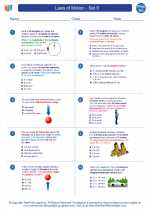Taxonomy
Taxonomy is the science of classifying and organizing living organisms into hierarchical categories based on their characteristics and evolutionary relationships. It helps in understanding and organizing the diversity of life on Earth.
Classification Levels
Organisms are classified into a hierarchy of seven major ranks, which are:
Binomial Nomenclature
The system of binomial nomenclature, introduced by Carl Linnaeus, is used to give each organism a unique, two-part scientific name consisting of its genus and species. For example, Homo sapiens (human) and Canis lupus (gray wolf).
Taxonomic Keys
Taxonomic keys are tools used to identify unknown organisms based on their characteristics. These keys consist of a series of choices between alternative characteristics, leading to the identification of the organism's scientific name.
Importance of Taxonomy
- Understanding biodiversity
- Assisting in evolutionary studies
- Facilitating accurate communication about organisms
- Providing a systematic approach for studying and organizing living organisms
Study Guide
To study taxonomy effectively, consider the following tips:
- Understand the concept of hierarchical classification levels and their significance in taxonomy.
- Learn the rules and principles of binomial nomenclature and practice naming organisms.
- Practice using taxonomic keys to identify different organisms.
- Explore the evolutionary relationships between different taxa and understand the importance of taxonomy in evolutionary studies.
- Review examples of different organisms and their classification into the hierarchical ranks.
Understanding taxonomy is essential for anyone interested in biology and the diversity of life. It provides a systematic framework for organizing and studying the immense variety of living organisms on our planet.
.◂Physics Worksheets and Study Guides High School. Laws of Motion - Set II

 Worksheet/Answer key
Worksheet/Answer key
 Worksheet/Answer key
Worksheet/Answer key
